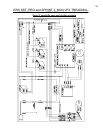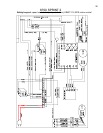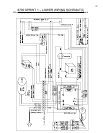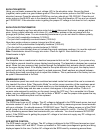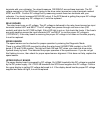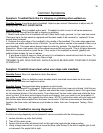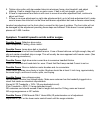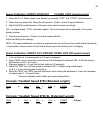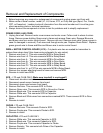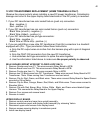
33
ELEVATION MOTOR
Using your voltmeter measure the input voltage (AC) to the elevation motor. Secure the black
(negative) meter probe to a good chassis ground. Place the red meter probe on the RED wire in the
elevation harness. Press the elevation DOWN key and you should get 120 /220VAC. Place the red
meter probe on the BLACK wire in the elevation harness. Press the elevation UP key and you should
get 120/220VAC. If the elevation motor is getting the proper AC voltage in but does not turn, replace
it.
ELEVATION POTENTIOMETER
Remove the elevation pot from elevation motor but do not disconnect the brown, orange and blue
wires. Using a digital voltmeter set to ohms (Ω), place meter probes on the pot prongs with the
(orange) and (brown) wires. You are measuring resistance so you do not need to observe polarity.
- Turn pot shaft completely clockwise (0-1000
Ω
).
- Turn pot shaft completely counterclockwise (1000-0
Ω
).
Now place meter probes on prongs (orange) and (blue) wires.
- Turn shaft of the potentiometer completely clockwise (1000-0
Ω
).
- Turn the shaft in completely counterclockwise (0-1000
Ω
)
If the elevation potentiometer does not indicate the proper resistance readings, it is must be replaced.
Note: Potentiometer should fit snugly into motor. Check for tight fit. Also check that nut on
Potentiometer is tight.
FACEPLATE
The faceplate has no mechanical or electrical components that can fail. However, if you press a key
and it fails to respond check for proper display board spacing. The faceplate is designed as a passive
panel. When the user presses a key (pushes through the faceplate) they activate a switch mounted
on the upper display board. If the display board to face plate distance is too great, the display board
switch will not be fully activated and result in a dead response. Small washers are placed between
the display board and mounting studs to adjust this distance. This is performed at the factory but can
be upset if disassembled in the field.
MEMBRANE PANEL
The membrane panel has small micro switches laminated inside that transmit the user’s commands
into treadmill functions. Enter “Diagnostic Mode” to confirm proper operation of the membrane panel.
In this test mode you will be able to check each key on the membrane panel. By pressing a key, you
will hear an audible beep and also see a numeric code appear in the speed window. There is a
numeric code assigned to each key on the panel (except the OFF key). For a complete list of these
codes, see your diagnostic guide. If you do not hear a “BEEP” or see the proper code appear the key
is bad and the membrane panel must be replaced.
PWM MOTOR CONTROL
The PWM board runs on AC voltage. The AC voltage is delivered to the PWM board across two input
terminals marked L1 and L2. Confirm AC voltage into the PWM by measuring across these terminals
with your voltmeter. You should measure 120/220VAC input. The DC voltage comes out of the PWM
board (going to the drive motor) across two output terminals marked A+ and A-. Confirm DC voltage
out by measuring across these two terminals with your voltmeter. You should measure 90/180VDC
output. If the PWM board is getting the proper AC voltage in but does not supply any DC voltage out,
it must be replaced.
SCR MOTOR CONTROL
The SCR board runs on AC voltage. The AC voltage is delivered to the SCR board across two input
terminals marked HOT and NEUT. Power up treadmill in OLS mode (see diagnostic guide) and bring
displayed speed to the max. Confirm AC voltage into the SCR board by measuring across these



